This website is supported by its readers. If you click one of my links I may earn a commission. I am also a participant in the Amazon affiliates programme and I will also earn a commission from qualified purchases.

Working from home can completely change your life. I mean let’s face it. Not having to worry about the day to day commute, having more freedom to dictate your schedule and just generally spending more time with your family are huge benefits!
That being said, Setting up a work from home policy or even proposing it to your team can be difficult. With my day job involving speaking to HR people day in and day out, the thing they always share with me is that you need facts and statistics to get the job done.
Luckily for you I’ve compiled 100 from the most reliable and recent global sources such as government sources, independent studies and reviews.
Now it’s worth mentioning that this post has a lot of information and so if you’re curious about the best equipment needed to work remotely simply go to my resource page here.
Also if you’re interested in finding out more about some business ideas you can try working from home, check out a post I wrote about it here.
General stats
Let’s look at some general stats to start off with to get an idea of what the current space of remote/flexible working currently looks like.
-
In 2020 4.3 million employees in the US workforce currently work remotely – this makes up about 5% of the current US workforce
This is huge as although this seems like a tiny percentage of the USAs current workforce, it is predicted this is going to shoot up rapidly over the coming years – get ready!
Source: Global Workplace Analytics
-
The number of employees who work remotely has increased by 173% by 2005
Again, another huge number. If this increases again over the next 10 years you will be looking at around 7.4 million remote workers, an increase of almost 4 million people.
Source: Global Workplace Analytics
-
Remote working has increased by almost 300% since 1996
This stat is even more shocking, with remote workers increasing roughly 170% every ten years, in 50 years this could mean that almost all american could be working remotely, if this stays on course at its current rate.
Source: Global Workplace Analytics
-
Working from home has increased 40% over the past 5 years
Now contrary to the other stats, remote working does seem to be slowing down over the past few years with only a 40% increase over the past five years, if this rate continues, the amount of growth over the next 10 years will be 80% as opposed to 173 percent as seen before.
Source: Global Workplace Analytics
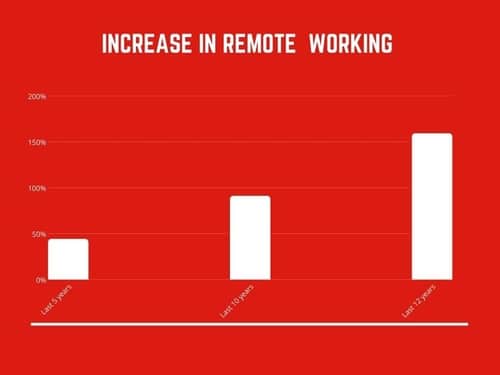
-
It’s estimated that 73% of all departments will have remote workers by 2028
This is huge, as it potentially means roles that are unable to currently be done remotely will definitely open up to remote working over the next few years.
Source: future workforce report
-
Remote workers work on average work 16.8 days per year more than their office based counterparts
Employers often cite lack of productivity as the main reason for not allowing remote work. The truth is the opposite, more employers should allow for this and will potentially see huge gains in productivity.
Source: Airtasker
-
Remote workers work on average work 1.4 days more per month than their office based counterparts
The 16 days we mentioned earlier averages out to about 1.4 days per month in total you will be getting back off of your employees.
Source: Airtasker
-
About ⅔ of managers feel as though their employees are more productive when they work from home
The perceived problem of remote workers does not seem to be in line with direct managers who view their employees as less productive. This misconception, it seems,is derived for those higher ups in firms.
Source: Airtasker
-
Remote working is more common in cities that are richer overall
Another super interesting stat about remote working is that employees who live in wealthier cities are much more likely to have the ability to work from home more often than not.
|
City Name |
Percentage of remote employees | Average salary |
| Encinitas | 9.57% | $103,842 |
| San Clemente | 8.56% | $101,841 |
| Highlands Ranch | 8.32% | $116,927 |
| Frisco | 8.31% | $120,701 |
| Alpharetta | 8.30% | $98,489 |
Source: Pragili
-
The number of jobs on Linkedin that offer flexible working has increase by 78%
The changing job market is not just an insider secret with a lot of famous job boards also now offering this.
Source: LinkedIn
-
16% of roles posted on We Work Remotely belonged to fully remote companies
Another interesting trend is that there are a growing number of roles that are just entirely remote working focus without any office based components.
Source: Usefyi
-
Organizations with a 100% Remote workforce have increased by 14% since 2014.
Another huge trend similar to the tone above is that more roles are becoming 100% romtoe with more organisations offering this as a viable option. This means that these types of organisations have to put a much greater emphasis on company culture to ensure people still do feel like a part of these firms.
Source: Usefyi
-
We work remotely has 2388 jobs posted on their site In 2018
Although fully remote working is on the rise only a small percentage of total jobs are fully remote in total
Source: Usefyi
-
We work remotely have had an increase in job postings by 7500%
Now this is huge as since the flexible working job site has been launched the number of jobs posted on the firm are increasing by a huge margin.
Source: Usefyi
-
49% of employers allowed their employees to set their own hours.
This means almost half of people in the modern workforce get to choose when they work – any productivity issues are going to be right in line with them.
Source: Conderco Software
-
The smaller an organisation is, the more likely it is to work remotely.
Initially I thought the opposite would be true with employees in start up being in the grind together, but the modern workforce has taken things in a completely different direction with more employees having the flexibility to work remotely, regardless of the size of a company.
Source: Usefyi
-
70% of fully remote workers have done so for the past 3 years
This is interesting as it seems like it’s only in the past few years that the number of remote workers has drastically increased.
Source: Usefyi
-
It’s estimated that in 2020 firms will save 4.2 trillion due to remote working.
This is due to a number of factors including improved productivity, the reduction in fixed overheads and increased agility amongst employees.
Source: flexjobs
Remote working by country
The next thing we will look at is remote working by country which should help break down exactly what the differences are by region
-
4.2 million people in the UK currently work remotely
This is quite a big figure with only 70 million people living in the UK the promotion of remote workers is huge
Source: ONS
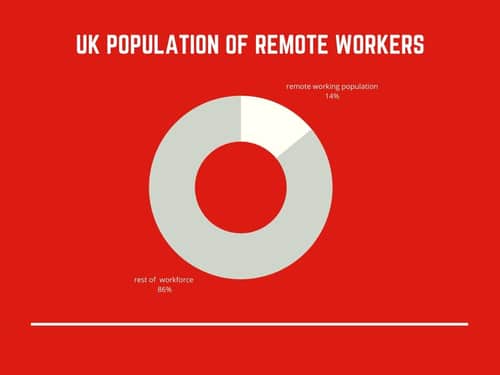
-
50% of the UK workforce is expected to work remotely by 2020
Again another huge stats as this means that around 30 million people in the UK will have the ability to work remotely as time goes on.
Source: ONS
-
20% of US employees who have the option to work remotely do so all of the time,
Another point to make to HR teams who might be hesitant to implement remote working full time is that only about 20% of employees who have the option to work remotely full time actually take up the offer to stay out of the office completely. It’s likely that employees will, in some aspects, stay committed to an organisation, onlychoising to go into the office when needs be.
Source: Gallup
-
54% of US employees work from home some do this some of the time
Following on from the above staff, 54% of employees who have the ability to work from home do so only part of the time, which, again, is great for potential HR teams who might be a little worried to let their employees do this full time.
Source: Gallup
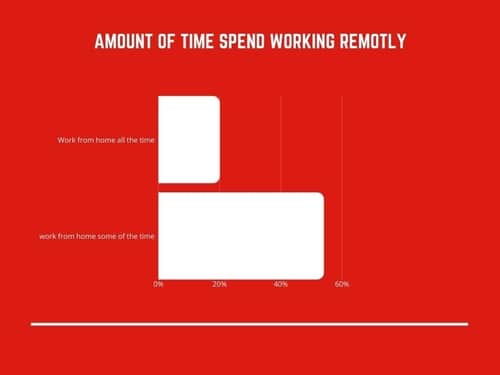
-
63% of global work forces have a work a remote working policy, 75% of this consider remote working to be the new normal
This is huge as it shows that working from home is not just a phenomenon in the US or Europe and that working from home. Remote working is really being seen as the new normal by a number of employees.
Source: IWG
| Country | Percentage of employees who have a flexible working policy | Percentage of employees who consider this to be the new normal | Source |
|
80% | 68% | IWG |
|
60% | 68% | IWG |
|
67% | 72% | IWG |
|
59% | 72% | IWG |
|
75% | 73% | IWG |
|
68% | 73% | IWG |
|
71% | 74% | IWG |
|
69% | 74% | IWG |
|
61% | 74% | IWG |
|
68% | 77% | IWG |
|
57.9 | 77% | IWG |
|
51% | 77% | IWG |
|
53% | 78% | IWG |
|
62% | 79% | IWG |
|
55% | 79% | IWG |
|
32% | 80% | IWG |
-
Japan has the overall highest number of employees who view remote working as the new normal.
This is contradictory to the fact that it has the smallest number of employees globally that allow for remote working.
Source: IWG
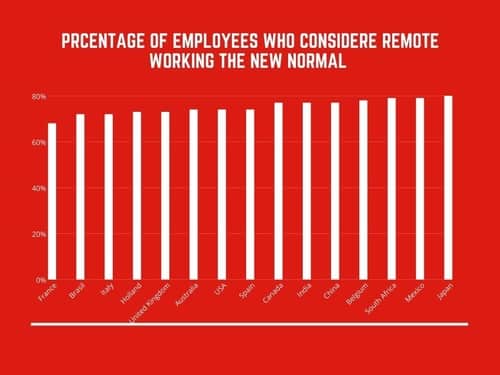
-
The Netherlands allows for more of its employees to work remotely than any other country globally
Roughly the same amount of their employees also see remote working as the new normal, which is more inline with what is happening in the country.
Source: IWG
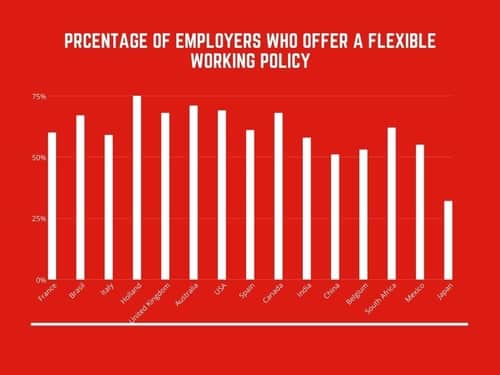
-
Tennessee state government saw a decrease of 37% in sick leave when they allowed their employees to work remotely
A super interesting case was in Tennessee where the state government saw a decrease of up to 37% in sick days when they allowed their workforce to work remotely. They also saved an estimated $1000 per month in gas bills.
Source: Deseret
-
Utah state government department is also increasing it’s amount of remote workers by 30% over the next year
Following on from the state of Tennessee, Utah decided to follow in their footsteps and allow a 30% increase in it’s workforce to gather some of the benefits of a remote workforce.
Source: Curbed Boston
-
Employees in Massachusetts are eligible for a $2000 tax credit if they work remotely.
This one is trippy. In the state of Massachusetts, organisations are being paid per employee to let their staff stay home.
Source: Deseret
-
Vermont’s commerce board is invite remote workers into the state and offering them $10,000 over the next 2 years to do so
The state of Vermont believes in remote working so much that they are enticing people new to the city and remote working in offering them a sizeable grant for doing so.
Source: Business insider
Remote working by industry and role
Industry is another area in which we can break down statistics of remote working, with industries that offer the most remote working being more surprising than you might have imagined.
-
Healthcare and technology companies have the most about of remote workers
This is interesting as people who opt for these roles will expect this as normal when applying for their jobs than other industry counterparts
Source: Usefyi
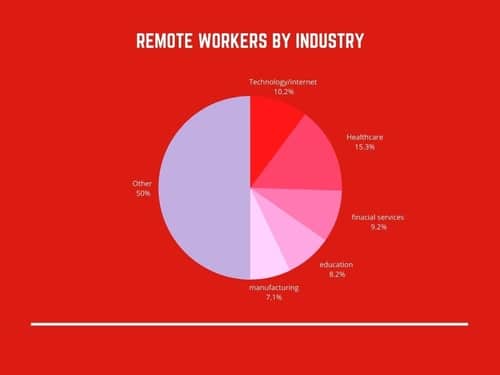
-
42% or remote workers plan on working remotely more frequently in the next five years
Again, another interesting stat showing that employees are now expecting to work remotely more frequently then they were allowed to even five years ago.
Source: Owl labs
-
More than half of on site workers want to work remotely
This stat shows that people who do not have the option to work remotely, still want the option to be able to do so.
Source: Owl Labs
-
9% of employers plan on offering their workforce less remote working opportunities over the next year
In line with all of the other statistics we’ve talked about today, only a tiny percentage of employers are going to reduce the amount of remote working allowed for their employees. It is definitely a work option that is here to stay.
Source: Condec Software
-
43% of employers plan to let their employees work remotely more in the next year than in the previous year
Counter to the stat we just showed above, almost half of all organisations are going to allow their workforce work remotely more in the upcoming 12 months.
Source: Condec Software
-
70% of the workforce will work remotely at least 5 days a month by 2025
Another exciting future trend is that almost ¾ of the workforce will work remotely at least a few days over the next 5 years. This is going to have a huge impact on organisations to set their employees up for success by giving them the right equipment
Source: Vox
-
18% more executives work remotely then worked on site
This links in with the stat that wealthier employees have a much larger ability to work remotely. It seems the higher you get in a firm the more likley you are to work remotely.
Source: Owl Labs
-
The highest number of remote workers are business founders/c-level executives (55%) and vp level staff 48%
It seems with remote working at least that bosses seem to have more of a day with amos half having the ability to work flexibly
Source: Owl Labs
-
70% of 18-34 year old’s are likely to take advantage of remote working
Young people are much more likely to take up remote working possibilities than their older counterparts, and yet it seems to be offered more so to senior employees.
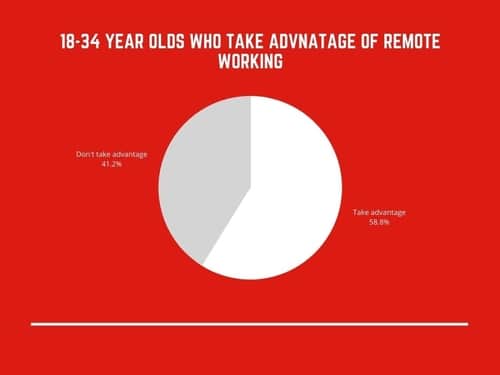
Source: Polycom
-
51% of 45-60 year old’s were likely to take advantage of remote working
Although less likely to take up remote working,. It seems that older employees still like the opportunity to be able to work remotely too.
Source: Polycom
-
Remote working paradigms are shifting
Whilst remote working is more common amongst younger staff, the paradigm of remote working is changing meaning that as time goes by, about the same percentage of employees will take up remote working and that statistics will even themselves out.
Source: Polycom
- Employees in their 20’s and 30’s value meaningful experiences more than their older counterparts
One of the major reasons cited for remote working by younger employees ( 18-36 year olds) is wanting to have more meaningful experiences than their older counterparts.
Source: Iwo Szapar, CEO Remote-How
-
68% of 16-29 year olds felt the biggest advantage to remote working was the ability to work productive
Younger employees view productivity as the most important thing in a modern role, ideally getting something done and getting it done fast seems like a super important task for them
Source: Polycom
-
74% of employees aged 60 + felt the biggest advantage of remote working was the control of work life balance
Older employees on the other hand found that the biggest advantage to working remotely was having a good work life balance.
Source: Polycom
-
13% of remote employees are less likely to take sick days and more likely to be productive
Following on from some of the other stats listed, once again, remote employees are much more productive than their office based counterparts.
| Age | Work life balance | Increased productivity | Avoid commute | More exercise | Save money on travel |
| 16-29 | 68% | 69% | 39% | 38% | 20% |
| 30-44 | 70% | 59% | 36% | 32% | 20% |
| 45-59 | 73% | 61% | 29% | 29% | 25% |
| 60+ | 74% | 64% | 22% | 27% | 28% |
Source: Stanford University
-
85% of global business agree that remote workers lead to a more productive workforce
One of the real positive stats for workers at least is that alsmot 85% of organisations believe that remote working is more productive. Itreally does mean that those who do not opt for remote working strategies really will be left behind when it comes to getting the best talent.
Source: IWG
-
85% of Australian business list talent attraction and retention for the main reason for remote working, this is the larger figure in the world
Attraction and retention are huge considerations for any HR team, so by having a solid tool like flexible working to allow for this will really set your organisation apart from your competitors.
Source: IWG
-
66% of Italian businesses use remote working as a way of attracting and retaining staff. This is the lowest in the world*
Italy, despite having the lowest figure in the world for attracting and retaining staff, still does find that it is a major consideration for their workforces.
Source: IWG
-
77% of organisations globally use a remote working policy to attract and retain staff
Globally, almost 80% of firms use remote working as a key way of standing out apart from a competitor. The bad news with that is that if most organizations do this, sooner or later they will need to look at other work schemes to make themselves stand out. What’s the old saying if everyone is special no one is?
Source: IWG
-
There is a 10% boost in retention when employers have the ability to choose their own work
One of the quickest ways to get an immediate boost from employee retention is by allowing your employees to choose their own work patterns. This does not necessarily mean remote working and could encompass various different things like holiday buy back or flexitime.
Source: Gartner Research
-
61% of people have considers switching roles due to lack of remote working ability
Another interesting statistic is that employees who do not offer flexible or remote working opportunities will actively seek out new places to work. Definitely something to keep in mind when trying to retain your staff.
Source: Flex Jobs
-
76% of workers stated that they would be more loyal to their employers if they had the ability to work remotely
Opposite to the statistic above it seems that employers who offer remote working can expect a more loyal and empowered workforce.
Source: Flex Jobs
-
70% of employees consider having remote working as a key factor when evaluating new career opportunities
This is easily the most shocking result of the list I think. Almost 70% or 1 in 7 employees will actively seek a new role based on remote working. In just a few short years the work landscape has changed massively.
Source: IWG
-
54% of employees feel as though remote working is more important than work for a prestigious company
Brand names don’t seem to be as appealing as they once were for modern workforce with employees citing work options more favourably than there actual places of work
Source: IWG
-
54% of employees feel as though remote working is more important than having a holiday allowance
This one surprised me, you know how much I love my holidays but by the sounds of it, having the ability to work remotely is more important than having a holiday.
Source: IWG
-
41% of employees feel as though working remotely is more important than never working overtime
I’m not sure about you but working overtime seems to have quieted down over the past few years. That being said, the number of people who would be happy to work from home and do overtime then not do overtime at all, comfort is crucial in your work environment it seems. .
Source: IWG
-
32% of employees feel as though remote working is more important than having a fancy job title
Again, another statistic I was shocked to come across, almost 1 in 3 employees would much rather have the ability to work remotely then have a fancy job/fancy job title.
Source: IWG
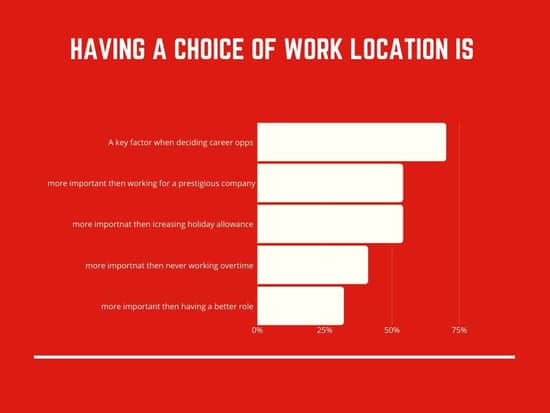
-
80% of remote workers are happier with their jobs then 55% of on site workers
Happiness is a key factor HR teams look at for their employees, with happier employees taking fewer sick days and are overall more productive. By having a remote working policy, HR teams can massively increase the happiness of their employees.
Source: Owl Labs
-
12.8 million days per year are lost to stress alone in the UK workforce
A shocking statistic is that almost 12 million days per year are lost to sick days related to stress every year in the UK. BY enabling remote working your workforce are much less likely to spend time away from their duties.
Source: HSE
Most common reasons for remote working
-
77% of people say that working remotely has improved their overall health
A great benefit of remote working is the amount of employees who say remote working has improved their wellbeing with almost 8 out of ten employees saying it has had a positive effect on their happiness.
Source: Flex Jobs
-
91% of employees cite a better work life balance as a reason to work remotely
Unsurprisingly one of the major reasons cited for working from home was the ability to get back in control of your work life balance.
Source: Owl Labs
-
79% of employees consider remote working for improved productivity
We touched on this several times already but not only does remote working increase employees productivity, employees believe this to be true too.
Source: Owl Labs
-
78% of employees consider remote working to avoid their commute
There is nothing worse than having to get up and travel an hour to work and so a commute is the third most cited reason to work remotely.
Source: Owl Lab
-
78% of people employees consider remote working to be less stressful
Stress can be a super important factor when working remotely with your colleagues sometimes being the ones responsible for your stress. Remote working obviously cuts out the middleman.
Source: Owl Labs
-
38% of employees use remote working to care for their older relative
On a more sombre note, almost half of people who work remotely do so to support those in need.
Source: Owl Labs
-
48% of employees cite childcare as the main reason they work remotely
One of the more obvious reasons as to why people work remotely is to, well, look after their kids – can’t blame them for that now can we!
Source: Owl Labs
-
44% of employees consider remote working to manage their disability
Another reason listed is that some employees need to work remotely to better manage their disabilities,which can often be difficult when having to commute to work.
Source: Owl Labs
-
43% of remote workers utilize remote working when moving home
We’ve all had those moments when we just aren’t enough hours in the day to work and move with us often taking months to completely move. Remote working can be super effective in these situations.
Source: Owl Labs
-
41% of employees work from home because they have no work office
With the increase in the number of roles that are solely remote based it is interesting to see that almost 4 out of every 10 employees who currently work remotely does not have a permanent office base.
Source: Owl Labs
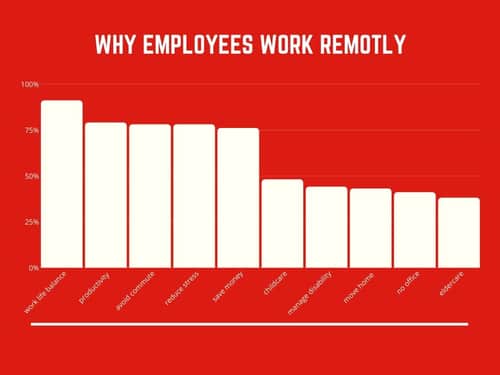
Problems with remote working
-
19% of remote workers struggle with loneliness when working remotely
Almost one in five employees struggles with loneliness when working from home. As such, it’s super important to make sure you are spending regular time staying connected to your colleagues when you are not with them.
Source: Buffer
-
22% of remote workers have problems switching off
This is something I struggle with, feeling like you can’t switch off and just head back to your laptop to work. Make sure you journal every day to keep track and only work your set hours that are allocated to you.
Source: Buffer
-
62% of employees need better technology to stay connected with their employees
Human beings are social creatures, even us introverts have to accept that, like I mentioned earlier, it’s super important to stay connected to not feel isolated and an outsider in your own organization.
Source: Buffer
-
Remote workers who work remotely once a month are 24% more likely to feel happier than their counterparts
Despite all of this, remote workers are still 24% more likely to be happier in their roles then their office based counterparts.
Source: Buffer
The demand for remote working
-
54% of employers would leave their job for remote working
Almost half of all employees would actively leave their roles for remote working which is huge. If you’re not offering this presently you could be down almost half your workforce which would obviously have catastrophic effects for your firm.
Source: Gallup
-
80% of employees would pick a role that offered flexible working over a role that would not
An interesting fact for those of you giving interviews, consider using this isn’t your back pocket if a prospective employee is choosing between two different roles.
Source: IWG
-
99% of remote workers want want to continue doing so for the rest of their careers
Easily the largest state is that almost every person who is remote working presently won’t go back to a role that does not offer remote working.
Source: Buffer
-
40% of employees would take on a heavier workload if they could work remotely
Another interesting one, it seems location is vital with employees not minding doing more so long as they have the ability to work remotely.
Source: Fuze
-
31% of employees would pay for their own technology if they have the ability to work remotely
Another nice stat is that remote working does not have to be super expensive with a number of employees opting to use their existing devices or pay for their own if they were allowed to work remotely.
Source: Fuze
-
24% of employees would give up their benefits to work remotely
Another surprising one for me ( as you know I work for a benefits company) is that one in five employees would give up all their work perks if they were allowed to work remotely.
Source: Fuze
-
18% of employees would take a pay cut or demotion to work remotely
Possibly the most shocking one is that employees would take a pay cut if they were allowed to work remotely, although that being said the numbers of employees who would do this are not very high.
Source: Fuze
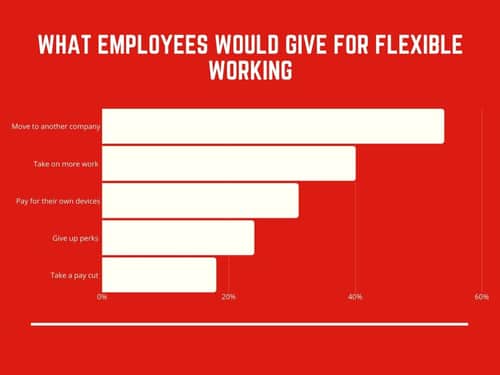
Remote working and finance
-
Companies will save on average $11,000 per employee if they are allowed to work from home for half the time
On average, organisations in the US would save about $11,000 per employee per year if they were not in half the time. A huge saving which could be used towards the wellbeing of its employees.
Source: Global workplace analytics
-
21% of employees would give up their holiday time to work remotely
Another shocking result I found was that almost one if five employees in the US would give up their holidays for the year if they were allowed to work remotely. Imagine all the time lost to vacations and how employers could maximise on this.
Source: Flex Jobs
Remote working and the environment
-
54 million tons of greenhouse gasses could be saved if all jobs that could be done remotely where undertaken for half the time
That number is almost unfathomable, but the simple truth is less people in the workplace means less cars on the road and less pollution.
Source: Global workplace analytics
-
Remote workers take away 119 billion miles of motorway driving per year
Again, like above, less cars on the road means less motorway driving.
Source: Global workplace analytics
-
Remote workers use 65 billion barrels of oil less then their office based counterparts.
This adds up to something like $64 billion every year
Source: Global workplace analytics
Finally a lot of people reading my blog want to know what products I recommend for a home office/remote working. You can find out my recommendations here and learn how I make money whilst working remotely on the side here.
The content on this on this site has been written by Fehed Nicass who has over a decades worth of experience in sales and has worked remotely for the past 2 years.
